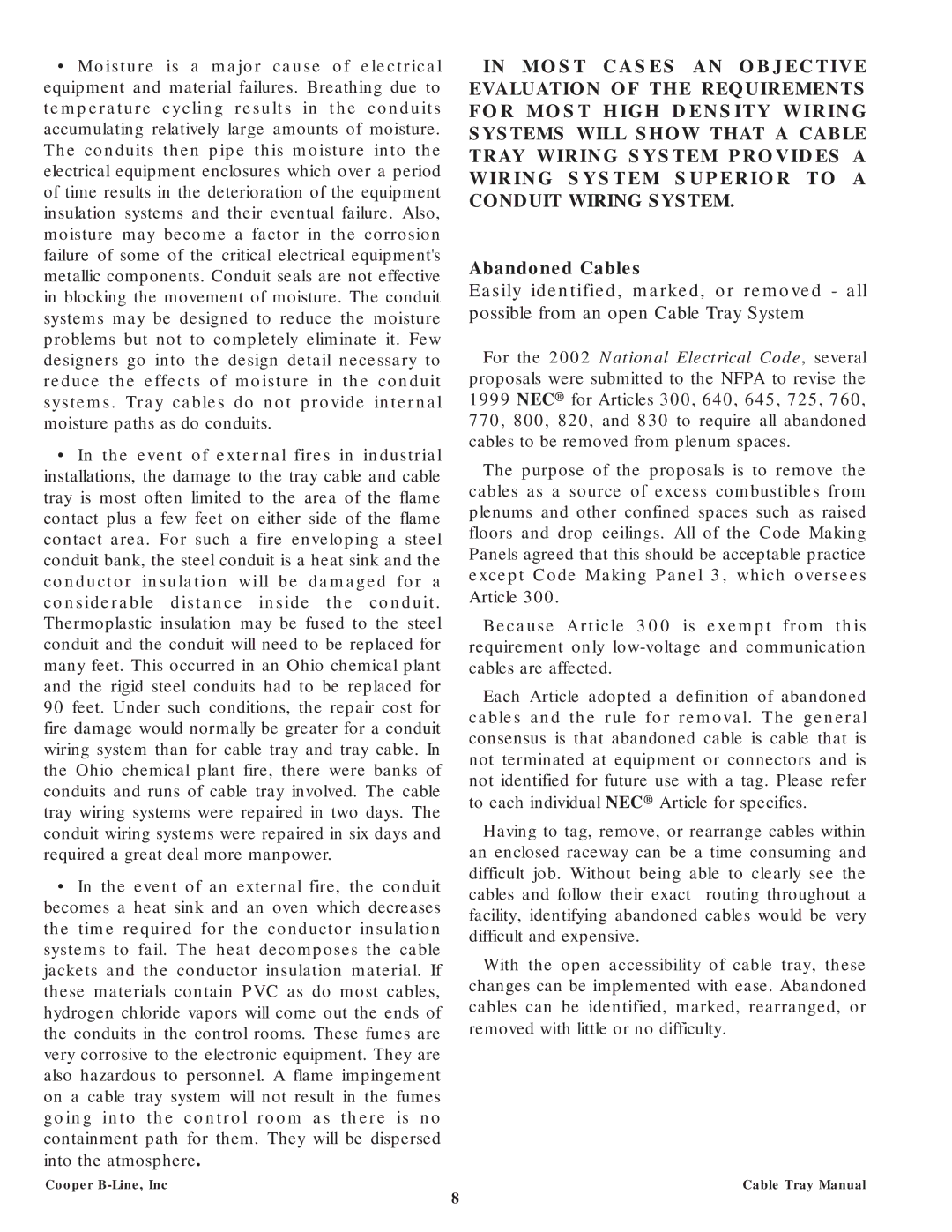•Moisture is a major cause of electrical equipment and material failures. Breathing due to temperature cycling results in the conduits accumulating relatively large amounts of moisture. The conduits then pipe this moisture into the electrical equipment enclosures which over a period of time results in the deterioration of the equipment insulation systems and their eventual failure. Also, moisture may become a factor in the corrosion failure of some of the critical electrical equipment's metallic components. Conduit seals are not effective in blocking the movement of moisture. The conduit systems may be designed to reduce the moisture problems but not to completely eliminate it. Few designers go into the design detail necessary to reduce the effects of moisture in the conduit systems. Tray cables do not provide internal moisture paths as do conduits.
•In the event of external fires in industrial installations, the damage to the tray cable and cable tray is most often limited to the area of the flame contact plus a few feet on either side of the flame contact area. For such a fire enveloping a steel conduit bank, the steel conduit is a heat sink and the conductor insulation will be damaged for a considerable distance inside the conduit. Thermoplastic insulation may be fused to the steel conduit and the conduit will need to be replaced for many feet. This occurred in an Ohio chemical plant and the rigid steel conduits had to be replaced for 90 feet. Under such conditions, the repair cost for fire damage would normally be greater for a conduit wiring system than for cable tray and tray cable. In the Ohio chemical plant fire, there were banks of conduits and runs of cable tray involved. The cable tray wiring systems were repaired in two days. The conduit wiring systems were repaired in six days and required a great deal more manpower.
•In the event of an external fire, the conduit becomes a heat sink and an oven which decreases the time required for the conductor insulation systems to fail. The heat decomposes the cable jackets and the conductor insulation material. If these materials contain PVC as do most cables, hydrogen chloride vapors will come out the ends of the conduits in the control rooms. These fumes are very corrosive to the electronic equipment. They are also hazardous to personnel. A flame impingement on a cable tray system will not result in the fumes going into the control room as there is no containment path for them. They will be dispersed into the atmosphere.
Cooper B-Line, Inc
IN MOST CASES AN OBJECTIVE EVALUATION OF THE REQUIREMENTS FOR MOST HIGH DENSITY WIRING SYSTEMS WILL SHOW THAT A CABLE TRAY WIRING SYSTEM PROVIDES A WIRING SYSTEM SUPERIOR TO A CONDUIT WIRING SYSTEM.
Abandoned Cables
Easily identified, marked, or removed - all possible from an open Cable Tray System
For the 2002 National Electrical Code, several proposals were submitted to the NFPA to revise the 1999 NEC® for Articles 300, 640, 645, 725, 760, 770, 800, 820, and 830 to require all abandoned cables to be removed from plenum spaces.
The purpose of the proposals is to remove the cables as a source of excess combustibles from plenums and other confined spaces such as raised floors and drop ceilings. All of the Code Making Panels agreed that this should be acceptable practice except Code Making Panel 3, which oversees Article 300.
Because Article 300 is exempt from this requirement only
Each Article adopted a definition of abandoned cables and the rule for removal. The general consensus is that abandoned cable is cable that is not terminated at equipment or connectors and is not identified for future use with a tag. Please refer to each individual NEC® Article for specifics.
Having to tag, remove, or rearrange cables within an enclosed raceway can be a time consuming and difficult job. Without being able to clearly see the cables and follow their exact routing throughout a facility, identifying abandoned cables would be very difficult and expensive.
With the open accessibility of cable tray, these changes can be implemented with ease. Abandoned cables can be identified, marked, rearranged, or removed with little or no difficulty.
Cable Tray Manual
8
